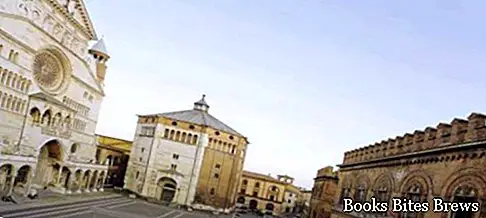What to see in Cremona, itinerary including the main monuments and places of interest, including historical workshops of luthiers, violin museum, cathedral and baptistery.
Tourist information
City of the Po Valley, Cremona is recognizable already in the distance by the imposing Torrazzo, the highest masonry bell tower in Italy, the symbol of the city.
The river Po flows on its periphery, and irrigates the beautiful countryside cultivated and dotted with typical farmhouses, in the typical landscape of the Po Valley.
The city was born in 218 BC. as a Roman colony, on a territory much favored by the proximity of the river Po, at the time closest to today's city as it flowed further north, and crossed by via Postumia, an important consular road.
During the twelfth century, the city became a free municipality and, thanks to the trade and control of the great waterway formed by the river Po, it experienced a very flourishing period.
Thus began the three centuries in which the city took shape, following various monastic settlements which involved reclamation works and contributed to the expansion of the inhabited center, with the construction of important architectural works, still present in the historic center.
When Bianca Maria Visconti brought the city as a dowry to her husband Francesco Sforza in 1441, beautiful buildings were built and a local pictorial school developed, but above all the art of violin making was born, the pride of this city.
In the sixteenth century Andrea Amati, founder of a famous family of luthiers, founded the Cremonese violin making school, carried on by his nephew Nicolò and, between the end of the seventeenth and the beginning of the eighteenth century, continued and perfected by unsurpassed masters, including Giuseppe Guarneri del Gesù and Antonio Stradivari.
What see
A visit to the city of Cremona allows you to relive the charm of this ancient art, through the workshops of luthier craftsmen who overlook the streets of the center, embellished by one of the most beautiful medieval squares in Italy, Piazza del Comune, where they overlook, The Torrazzo, the Duomo, the Baptistery, the Loggia dei Militi and the Palazzo del Comune.
The Duomo, built during the twelfth century and enlarged in the transept in the thirteenth and fourteenth centuries, is one of the most significant examples of Lombard Romanesque architecture.
The Violin Museum houses five centuries of Cremonese violin making, with evidence relating to great masters such as Amati, Stradivari and Guarneri.
Recommended readings- Lombardy: Sunday day trips
- Varese (Lombardy): what to see
- Valcamonica (Lombardy): what to see and rock carvings
- Pavia (Lombardy): what to see
- Lake Iseo (Lombardy): what to see in 1 day
The typical dessert of Cremona is the nougat, every year in November the "Festa del Torrone" takes place, with a series of cultural and food and wine events.
Tradition says that, during the wedding banquet of Francesco Sforza and Bianca Maria Visconti, a first version of the Cremona nougat was served.
One of the most folkloric moments of the party is precisely the historical re-enactment of this wedding.




